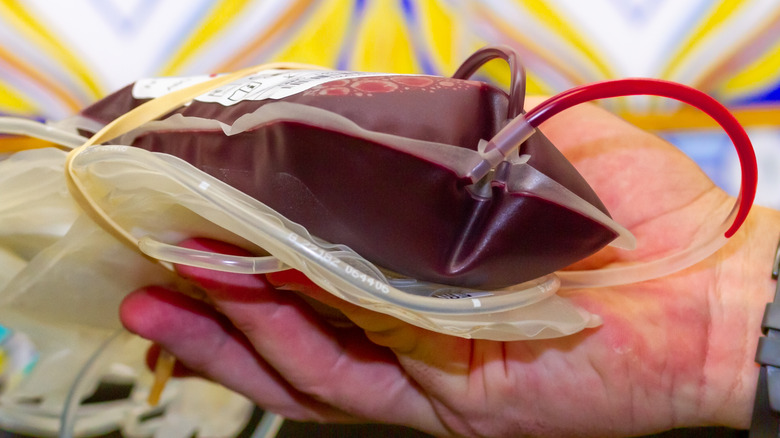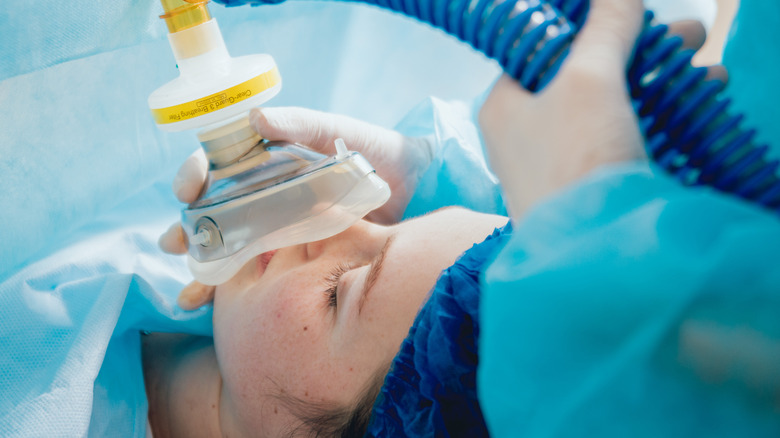11 Unexpected Triggers Of Anaphylaxis
Anaphylaxis is a potentially fatal allergic reaction that can happen immediately or up to hours after exposure to an allergen without warning, per the Mayo Clinic. While specific allergens, such as peanuts or bee stings, are well-known triggers of anaphylaxis, many other unexpected triggers can also cause this reaction. Some symptoms to be aware of with anaphylaxis are difficulty breathing, swelling of the face, lips, and tongue, rapid or weak pulse, nausea, vomiting, and low blood pressure. These symptoms occur due to the body's immune system response to the trigger.
According to a study published in the Journal of Allergy and Clinical Immunology in Practice, anaphylaxis is challenging to quantify because it is frequently underreported. Still, it is estimated to affect approximately 5% of the United States population. People with allergies or asthma history may be more vulnerable to developing anaphylaxis. Furthermore, many potential triggers may be unexpected or surprising. It is essential to be aware of potential triggers, especially if you have a history of anaphylaxis. Knowing how to respond can save your life or the life of someone around you.
Exercise is a potential trigger of anaphylaxis
Could you be allergic to exercise? People may joke from time to time that they are allergic to exercise to get out of the act of actually exercising. However, anaphylaxis induced by exercise is an actual condition in which anaphylaxis is triggered by physical activity. It is more common in people with preexisting conditions like asthma, hay fever, or food allergies. The World Allergy Organization believes that exercise-induced anaphylaxis is caused by a combination of physical activity and the ingestion of certain triggering substances, such as certain foods or medications, before exercising.
The body's physiological responses during exercise include increased heart rate, blood flow, and respiratory rate. According to DermNet, up to 15% of anaphylaxis cases are induced by exercise, as the physiological changes can lead to an increased release of chemicals such as histamine, which can cause allergic symptoms. In addition, exercise may cause the body to produce other chemicals that can trigger an allergic reaction. DermNet also mentions that specific symptoms may appear as warning signs before a full onset of anaphylaxis occurs. These symptoms include generalized itching, swelling, and fatigue.
It's important to note that exercise-induced anaphylaxis is uncommon, and most people with allergies or asthma can exercise safely. However, if you have a history of allergies or anaphylaxis and are concerned about the possibility of an allergic reaction during exercise, you should consult your doctor and take appropriate precautions.
The cold can trigger an anaphylactic reaction in some people
While some people may simply dislike going outside in cold weather, cold conditions can actually cause health problems for certain folks. Cold temperatures, water, or anything extremely cold can cause an allergic reaction that could lead to anaphylaxis on rare occasions.
According to the Mayo Clinic, the allergic reaction is known as cold urticaria. This condition can manifest within a very short period of time after exposure to the cold. Cold urticaria produces itchy bumps on the exposed area. These bumps are also known as hives. Additionally, cold urticaria can progress to anaphylaxis. Therefore, it is essential to recognize early symptoms such as hives, swelling, and redness of the fingers or hands. It is also possible to experience swelling of the lips when drinking a cold beverage in susceptible people.
Per University Hospitals, most triggers are unknown. In rare cases, the culprit may be an inherited reason from a genetic mutation. An anaphylactic reaction can present as palpitations and difficulty breathing, including wheezing. If you have a history of this reaction, you must discuss the symptoms with your doctor to determine if an Epi-Pen may be needed.
Heat-induced anaphylaxis
Like most people, you may enjoy spending time outside when the weather is nice and the sun is shining. You may have overheated while participating in certain activities, but did you know that heat can also cause anaphylactic reactions? Heat-induced anaphylaxis is a rare type that happens suddenly and can be fatal. It can be caused by exposure to high temperatures, such as hot baths, saunas, or fevers. It can also be triggered by sun exposure or hot weather.
Typically, symptoms begin with cholinergic urticaria, which causes hives or whelps on the skin due to heat exposure (via WebMD). Heat exposure causes this type of urticaria, which can be a precursor to developing anaphylaxis. As a result, if you notice hives or bumps developing, you should stop whatever is causing heat in or around your body to avoid a serious condition (per Medical News Today).
According to NHS, heat-related anaphylaxis is more common in people with certain underlying medical conditions, such as mastocytosis, a rare immune system disorder. Mastocytosis is characterized by a high number of mast cells in the body and the release of an abnormally large amount of histamine. When this happens, you are more likely to develop anaphylaxis. However, the exact cause of mastocytosis is unknown. There is some speculation that a genetic mutation is to blame. You should consult your doctor if you suspect you may be at risk for heat-related anaphylaxis.
Booze and anaphylaxis
Alcoholic beverages can contain other allergens or ingredients that may cause an allergic reaction, such as tree nuts, peanuts, wheat, soy, and egg (via Erudus). If you are allergic to any of these substances, it is essential to read labels carefully and avoid beverages that contain them. Allergens can hide in alcohol and cause an anaphylactic reaction if you consume an alcoholic beverage without knowing the ingredients.
An allergy to alcohol occurs when the body's immune system perceives alcohol as a harmful substance and produces antibodies to try to remove it from the body (per WebMD). As a result, an allergic or anaphylactic reaction may occur. Furthermore, while alcohol allergies are uncommon, it could be triggered by just a sip or two of an alcoholic beverage.
According to a study published in Case Reports in Dermatology, another way that alcohol can cause anaphylaxis is through immunological reactions. It can begin as dermatitis and quickly advance to anaphylaxis. Fatal reactions have even been reported, necessitating further investigation. One possibility is that the individual is allergic to one of the ethanol constituents of the alcoholic beverage. Per the study, the allergen in the immune response came from the breakdown of ethanol into acetic acid. Therefore, acetic acid was discovered to be the contributor to anaphylaxis, not directly from ethanol as speculated but from the breakdown of ethanol into the byproduct acetic acid.
The hidden risk of latex exposure
Latex is found in everyday items, including gloves, underwear bands, tennis shoes, balloons, rubber bands, condoms, and even the nipples on baby bottles and pacifiers. It's easy to imagine how terrifying it would be if you had a severe latex allergy that caused anaphylaxis. Even if you are not allergic to this versatile material, the variety of products that contain it may surprise you (via the American College of Allergy, Asthma, and Immunology).
So, precisely what is latex? Latex is a natural rubber to which some people may develop an allergy if repeatedly exposed. The reaction may begin mildly, but it can quickly escalate into a severe anaphylactic reaction with little warning.
According to the Mayo Clinic, people allergic to latex may experience anaphylaxis simply by inhaling latex particles in the air. People who work in health care or other industries that frequently use latex gloves are more likely to develop a latex allergy. Furthermore, people with multiple surgical procedures or hospital visits are more likely to develop a latex allergy, putting them at risk for anaphylactic reactions.
There are several ways to avoid latex allergy-related anaphylaxis, according to the Centers for Disease Control and Prevention (CDC). One is to avoid products containing latex, which can be difficult as it is found in many everyday products. Latex substitutes such as nitrile or vinyl gloves are another option. Lastly, people with a known latex allergy should always keep an EpiPen.
Beware of food additives, as they could cause anaphylaxis
Food additives are substances added to food to improve its flavor, appearance, or preservation (via the World Health Organization). While most food additives are safe to consume, some people can have an allergic reaction to certain additives, known as an anaphylactic reaction.
Food additives reported to cause anaphylaxis reactions, according to a study published in the Interdisciplinary Journal of Allergy, Clinical Immunology, and Environmental Medicine, include preservatives, colorings, thickeners, and flavorings. For example, people allergic to sulfites, a common preservative found in dried fruit, wine, and processed foods, may develop anaphylaxis after consuming these products. Similarly, people allergic to food colorings such as yellow dye five and red dye 40 may produce anaphylaxis after consuming foods or beverages containing these additives.
According to The New York Times, while anaphylaxis can occur from ingesting food additives, most allergists believe it is uncommon. If you suspect you are allergic to a food additive or have previously had an anaphylactic reaction to one, you should seek medical attention. Your healthcare provider can help determine the best course of action to determine what may be causing the adverse reaction. It is also critical to carefully read food labels and avoid products containing allergenic additives (via FARE).
Don't let anaphylaxis ruin your radiology procedure
Any radiology procedure that uses a contrast agent can cause an anaphylactic reaction. A study published in La Radiologia Medica mentions that these agents are vital to ensure good visibility of internal structures, such as organs and blood vessels, in medical images. Therefore, it is common for contrast agents to be used in radiology procedures such as computed tomography (CT) scans, magnetic resonance imaging (MRI) scans, and angiography, a type of X-ray procedure used to visualize the blood vessels.
With that said, anaphylactic reactions to contrast agents are uncommon. The Journal of Allergy and Clinical Immunology in Practice pointed out in a published study that most people who receive a contrast agent for a radiology procedure have no problems. However, if you have a history of allergies or have had an anaphylactic reaction to a contrast agent, you should notify your healthcare provider before a radiology procedure. They can give medication before the procedure to help prevent anaphylaxis, and will be prepared should you show signs of reacting to the contrast.
Don't let a reaction to semen ruin your love life
A semen allergy, also known as seminal plasma hypersensitivity, is an uncommon allergic reaction to proteins found in seminal fluid (via Science Alert). It can cause symptoms such as genital redness, swelling, and itching. It can also cause anaphylaxis, such as difficulty breathing, nausea, and vomiting in severe cases.
Usually, the immune system protects the body from harmful substances such as bacteria and viruses. In people with allergies, however, the immune system misidentifies a normally harmless substance as dangerous and mounts an immune response against it (via Pfizer). A study published in Allergy, Asthma and Clinical Immunology found that in the case of a semen allergy and anaphylaxis, the immune system responds to proteins in the sperm by producing antibodies known as immunoglobulin E (IgE). These antibodies cause histamine and other chemicals to be released, which can result in allergic symptoms.
The precise cause of a semen allergy is unknown. However, if you have a family history of allergies or a weakened immune system, you may be more prone to developing a semen allergy. A semen allergy may be treated by avoiding contact with semen. Additionally, desensitization therapy may help the body become less sensitive to the proteins in sperm. This is useful if pregnancy is desired, as mentioned in a Clinical and Molecular Allergy study. Consultation with a healthcare provider is essential to ensure proper diagnosis and treatment so that you and your partner can remain intimate.
The unexpected risk of blood transfusions
A blood transfusion may be recommended if you are anemic or need blood due to a loss. This medical miracle involves injecting donated blood that has been carefully matched to your specific needs into your body through an IV line. Blood is matched by comparing the donor and recipient's blood type and Rh factor (via Mayo Clinic). The goal is to find a donor with a compatible blood type that will not trigger an immune response in the recipient. As a result of this process, blood transfusions are usually safe and effective, but there is a slight chance that an anaphylactic reaction or other adverse reaction will occur.
According to the American Association of Clinic Chemistry (AACC), allergic reactions are common in transfusions and usually happen minutes after the transfusion begins. Knowing the symptoms of an allergic reaction is essential so you can proactively inform your healthcare provider before an actual anaphylactic reaction occurs. If you develop itching, hives, chills, or a fever, your healthcare provider will stop the transfusion and may administer medication to relieve the reaction (via American Red Cross).
Canadian Blood Services reports that anaphylactic reactions to blood transfusions occur up to 5.9 times per 100,000. Some symptoms that may present are difficulty breathing, chest tightness, nausea, vomiting, hives, and low blood pressure. Anaphylaxis can be fatal if not treated promptly.
The dangers of anesthesia: malignant hyperthermia and anaphylaxis
There are various types of anesthesia; some are more likely to cause anaphylaxis than others. However, it is difficult to determine which ones may cause a reaction if there is no previous history of an allergy. According to a study published in Anesthesia Essays and Researches, anaphylaxis during anesthesia can be difficult to detect in the early stages because the patient is asleep, and the drapes used for the sterile field cover the skin, making any immediate skin reaction challenging to see.
One such concern with anesthesia is malignant hyperthermia, a rare, inherited condition that can result in a potentially fatal reaction to certain types of anesthesia, particularly inhaled anesthetics (per MedlinePlus). A rapid rise in body temperature, muscle rigidity, and an irregular heartbeat distinguish it. If left untreated, it can lead to severe complications such as organ damage and death. People with a family history of the condition are more likely to develop it.
An article published in The British Journal of Anaesthesia states that surgery is a standard medical procedure that frequently necessitates the administration of multiple medications, including antibiotics, anesthesia gases, sedatives, and pain relievers. Because all these medications are being administered simultaneously, patients are at a higher risk of developing an adverse reaction. Stay vigilant and discuss any potential allergies or sensitivities with your healthcare provider to ensure the safest and most successful surgery possible.
Could your period cause anaphylaxis?
The menstrual cycle is the natural process through which a woman's body prepares for pregnancy each month. Given this fact, it may surprise you that the female menstrual cycle can cause an anaphylactic reaction.
There are a few reports of women having anaphylactic reactions during their menstrual cycle. A study in BMJ Case Reports mentions that these cases are referred to as cyclical or catamenial anaphylaxis. The response is thought to be triggered by the release of progesterone, a hormone produced by the ovaries and the adrenal glands. It plays several critical roles in the body, including maintaining pregnancy, regulating the menstrual cycle, and preparing the breasts for lactation. Progesterone levels vary throughout the menstrual cycle and are highest during the luteal phase, which occurs after ovulation. It is during the luteal phase that the highest risk of anaphylaxis can occur.
It is important to note that anaphylaxis during the menstrual cycle is uncommon, and most women do not have allergic reactions during their period. You should see a doctor for proper diagnosis and treatment if you are experiencing severe allergic symptoms during your menstrual cycle.












